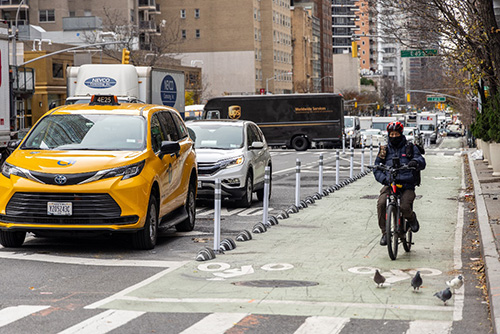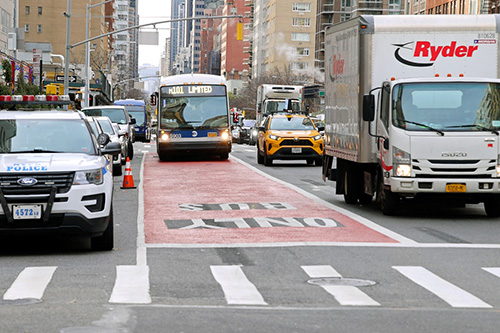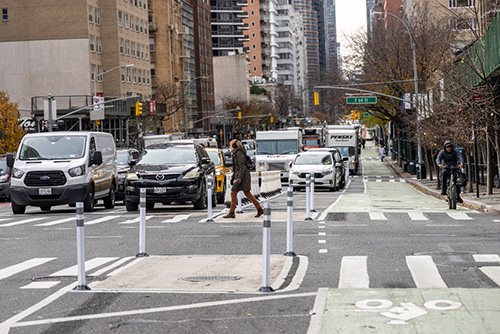Press Releases
IMMEDIATE RELEASE
December 7, 2023
Contact: (212) 839-4850, press@dot.nyc.gov
NYC DOT Celebrates Completion of Major Safety Project on Manhattan's Third Avenue
Transformative project redesigned dangerous intersections, reduces speeding, and added 1.9 miles of bike and bus lanes in corridor that has seen a high number of severe injuries and fatalities
New design features wider bike lanes to better accommodate record-breaking bike ridership and creates a more welcoming, comfortable cycling experience

As part of the "Complete Street" redesign of Third Avenue in Midtown and the Upper East Side, NYC DOT has added 11-foot bike lanes along two uphill segments of Third Avenue to create passing lanes where faster e-mobility users can safely pass pedal cyclists.
New York – New York City Department of Transportation (NYC DOT) Commissioner Ydanis Rodriguez today celebrated the completion of a major street safety project on Third Avenue in Midtown and the Upper East Side. The completed project spans nearly 40 blocks from East 59th to East 96th streets, a stretch of Third Avenue that has seen 37 severe injuries and seven traffic fatalities between 2016 and 2022. The project includes a redesign of every intersection, traffic calming measures to reduce speeding, a new offset bus lane, and a parking-protected bicycle lane. The "Complete Street" project, which better accommodates all road users, will also deliver faster, more reliable bus service for 50,000 daily riders along the corridor. With the completion of the Third Avenue redesign, NYC DOT expects to deliver a record high number of protected bike lanes this year.
"This transformative redesign of Third Avenue will make the street safer for everyone—whether you are walking, biking, or driving—and helps prioritize the tens of thousands of bus riders who rely on this street every day for safe bus service," said NYC DOT Commissioner Ydanis Rodriguez. "Through this 'Complete Street,' and projects across the city, we are working every day to make our streets safer and to make it easier for New Yorkers to get around our city."
To better accommodate record high bike ridership and expected future growth, NYC DOT installed wider segments of bike lanes along Third Avenue, which will make cycling conditions safer and more comfortable. The new bike lane marks the third project in 2023 where NYC DOT has installed wider bicycle lanes, following implementation on Ninth and Tenth avenues this year.
The lane also complements the heavily used First Avenue protected lane as an additional northbound route for bike riders on Manhattan's East Side. NYC DOT will monitor, evaluate, and make adjustments to the project as needed. The monitoring process will include reviewing both designs and behavior in terms of how the widened bike lane is being utilized and how cyclists are adapting. The monitoring framework will also measure the capacity of the bike lane and whether it can safely and comfortably accommodate micromobility growth.
These efforts build upon the Adams administration's Charge Safe, Ride Safe E-mobility Action Plan announced earlier this year by incorporating street designs that accommodate the growth of micromobility devices on city streets—and make riding both safer and easier.
Bus Rider Benefits
Third Avenue serves the M98, M101, M102, and M103 bus routes, with over 150 buses traveling along Third Avenue during the morning peak hour (8-9 a.m.). On average, buses travel at 5.4 miles per hour in the morning peak (6-10 a.m.), and 5.2 miles per hour in the evening peak (3-7 p.m.)—far below the average across the city. The project also added an offset bus lane to Third Avenue. Offset bus lanes use the lane adjacent to the parking lane; by retaining space for parking and loading, the bus lane is kept clear for buses. These improvements complement NYC DOT's installation of Transit Signal Priority (TSP) on Third Avenue between East 7th and 125th streets earlier this year. TSP is a technology that improves bus speeds by reducing the time approaching buses wait at signalized intersections—either by speeding up a red signal to turn green, or by holding a green signal.
The offset bus lane also complements existing bus lanes on First Avenue, Second Avenue, and Lexington Avenue, and will provide connections to the Q32, Q60, Q101, M66, M72, M79 SBS, M86 SBS, and M96 services.

The new bus lane on Third Avenue will make commutes faster and more reliable for 50,000 daily bus riders on the M98, M101, M102, and M103 routes.
Wider Bike Lane Designs
The new bike lane on Third Avenue is nine feet wide with a three-foot buffer—notably wider than most protected lanes along Manhattan avenues, which are typically six feet wide with a five-foot buffer.
NYC DOT has added even wider, 11-foot bike lanes along two uphill segments of Third Avenue—between 64th and 66th streets, as well as between 80th to 82nd streets—to create passing lanes where faster e-mobility users can safely pass pedal cyclists.
At eight intersections with signalized left turn lanes, NYC DOT has also widened bike lanes to 10 feet and protected those bike lanes with physical barriers. Wider lanes create comfortable passing space as riders approach green signals and additional room for riders waiting at red signals.
The benefits lane widening deliver for micromobility will not only come in the form of travel speeds, but also provide a more comfortable space for cargo bikes used for deliveries and families.
Wider bike lane segments are clearly marked with two side-by-side bike stencils. NYC DOT staff will be monitoring the designs and rider behavior and will be surveying users on their experience.
Daylighting and Safety Treatments
NYC DOT has also built pedestrian islands to improve visibility at intersections, known as "daylighting," and reduce the time it takes pedestrians to cross the street. At targeted intersections, NYC DOT installed "offset crossings," which improve visibility between cyclists, pedestrians, and drivers, and naturally slow driver turns. Other redesigns include adding left turn lanes with dedicated turn signals to reduce conflict between turning vehicles and cyclists and pedestrians.

NYC DOT installed pedestrian islands along Third Avenue to shorten the time it takes pedestrians to cross the street and improve visibility for all road users.
The project also created two new layover areas for delivery workers, designed to keep sidewalks clear by providing delivery workers space to rest or wait for deliveries. These layovers are at locations with high volumes of deliveries on Third Avenue, between 84th and 85th streets, and between 86th and 87th streets. The agency created these areas by installing painted mid-block sidewalk extensions along with bike corrals, planters, and granite blocks to protect these spaces.
NYC DOT is exploring additional safety upgrades along Manhattan's entire Third Avenue corridor, but the agency began work where the highest number of traffic fatalities have occurred in recent years. Between 2016 and 2022, six pedestrians and one cyclist have been killed between East 59th and East 96th streets.
The Third Avenue project was the result of significant community engagement, with the design supported by Manhattan Community Board 8, which covers the entire Upper East Side.
"You can practically hear the cheers of cyclists along Third Avenue – this is a major win for safety along one of Manhattan's busiest boulevards," said Manhattan Borough President Mark Levine. "This innovative approach to accommodating a variety of modes of transportation sets a new precedent for keeping Manhattan moving safely."
"I commend today's opening of the redesigned 3rd Avenue that adds protected bike lanes, dedicated bus lanes, and more to calm traffic, reducing traffic violence in an area that has seen seven fatalities since 2016," said U.S. Representative Jerrold Nadler. "This redesign will accommodate expected future growth in micromobility and bicycle riders, incentivizing alternatives to private car travel, simultaneously reducing emissions and making New York safer for residents and visitors alike."
"I commend Commissioner Ydanis Rodriguez for NYC DOT's vital project to improve transit and safety throughout New York," said Assemblymember Rebecca A. Seawright. "Third Avenue's now-completed redesign makes our streets safer for pedestrians, bicyclists, and motorists alike."
"I look forward to seeing the results of the Third Avenue Redesign," said New York City Council Majority Whip Selvena N. Brooks-Powers. "As Chair of the Committee on Transportation and Infrastructure, improved street safety and efficiency are some of my top priorities. This includes street calming measures like daylighting at intersections and offset bus lanes. I hope these necessary changes will speak for themselves and inspire similar improvements throughout the City."
"The completion of the Third Avenue redesign heralds major speed and safety improvements for the 50,000+ transit riders, bicyclists and pedestrians that use the street every day," said City Council Majority Leader Keith Powers. "The redesigned Third Avenue demonstrates how we can accommodate all road users in a safe and efficient manner."
"Today marks a transformative milestone as we celebrate the completion of the Third Avenue street safety project. These necessary upgrades could improve pedestrian safety, deliver faster bus service and make cycling a more comfortable experience," said City Councilmember Julie Menin. "The New York City Department of Transportation is truly prioritizing a safer, more accessible New York City—where every commuter, cyclist, and pedestrian can navigate our bustling streets with confidence."
"Bus lanes and busways make New York's streets fairer and safer," said Riders Alliance Senior Organizer Jolyse Race. "Thanks to DOT's Complete Streets project on Manhattan's Third Avenue, 50,000 bus riders now will save precious time and enjoy faster, more reliable service. Millions of riders across the city are demanding more busways and bus lanes to speed up service and stop dangerous crashes."
"The NYC Department of Transportation's ongoing focus on safe and efficient transportation for all is a boon to New York City," said Ken Podziba, CEO of Bike New York. "The widened and protected bike lanes on both First and Third Avenues will create safer and more efficient movement throughout the city. Particularly exciting about this project is the continued monitoring and commitment to future adaptations as the needs of the cycling community shift in response to these improved corridors. Projects like these, which take into account the reality of urban movement, will make New York City the gold standard for city cycling in the US."
"Complete Streets are the way forward," said Sara Lind, Co-Executive Director at Open Plans. "This project brings 3rd Avenue into the 21st century, turning 40 blocks of chaotic, car-centric roadway into a corridor that considers, and cares for, all users. We love to see holistic approaches like this. The use of wider, protected lanes will makes lanes safer and more accessible, and DOT’s commitment to continued monitoring will ensure our infrastructure meets future mobility demand as it grows and shifts."
